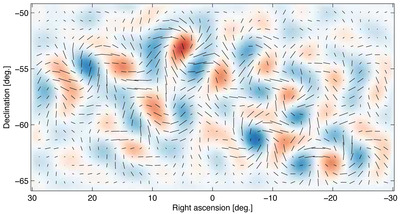First evidence of cosmic inflation found
Researchers from the BICEP2 collaboration have announced the first direct evidence of cosmic inflation - the rapid expansion of the universe which immediately followed the Big Bang. Until now, the idea of this exponential expansion was just a theory.
The results came from observations by the BICEP2 telescope, which was based at the South Pole during the study. The leader of the collaboration, John Kovac, explained that the South Pole is “one of the driest and clearest locations on Earth - perfect for observing the faint microwaves from the Big Bang”.
The telescope was continually scanning the sky for variations in the cosmic microwave background (CMB) - a faint glow left over from the Big Bang. Tiny fluctuations in this afterglow provide clues to conditions in the early universe. For example, small differences in temperature across the sky show where parts of the universe were denser, eventually condensing into galaxies and galactic clusters.
Since the CMB is a form of light, it exhibits all the properties of light, including polarisation. On Earth, sunlight is scattered by the atmosphere and becomes polarised, which is why polarised sunglasses help reduce glare. In space, the CMB was scattered by atoms and electrons and became polarised too.
“Our team hunted for a special type of polarisation called ‘B-modes’, which represents a twisting or ‘curl’ pattern in the polarised orientations of the ancient light,” said co-leader Jamie Bock. This curl is created by gravitational waves - described as the ‘first tremors of the Big Bang’ - which squeeze space as they travel, producing a distinct pattern in the CMB.

Gravitational waves have a ‘handedness’, much like light waves, and can have left- and right-handed polarisations. Co-leader Chao-Lin Kuo explained, “The swirly B-mode pattern is a unique signature of gravitational waves because of their handedness.”
After examining spatial scales on the sky spanning about 1-5° (two to 10 times the width of the full Moon), the team detected a B-mode polarisation signal considerably stronger than many cosmologists expected. They analysed their data for more than three years, in an effort to rule out any errors, and considered, but ultimately doubted, that dust in our galaxy could produce the observed pattern.
“The most parsimonious explanation is that we are seeing the imprint of gravitational waves on a cosmological scale,” said team member Brian Keating. “That will surely be the conclusion if our results can be confirmed. Many competitors are close to detecting this signal, so we’ll know soon.”
Harvard theorist Avi Loeb said the results are “not only a smoking gun for inflation; they also tell us when inflation took place and how powerful the process was”.
Co-leader Clem Pryke added, “This has been like looking for a needle in a haystack, but instead we found a crowbar.”
Technical details can be found at http://bicepkeck.org.
Light pollution promotes blue-green algae growth in lakes
Artificial light at night promotes the proliferation of cyanobacteria, also known as blue-green...
Solar-powered reactor uses CO2 to make sustainable fuel
Researchers have developed a reactor that pulls carbon dioxide directly from the air and converts...
Scientists simulate the effects of an asteroid collision
How would our planet physically react to a future asteroid strike? Researchers simulated an...




